Abstract
The storage of livestock manure is responsible for ammonia emissions into the atmosphere. Different natural covers could be used during animal manure storage, but the mitigation effect is influenced by the manure characteristics due to the housing or treatment systems. Starting from cattle and buffalo manure, the objectives of this study were (i) to assess the effect of anaerobic digestion (AD) and solid–liquid separation (SLS) on ammonia emissions during storage as well as natural crust development and (ii) to investigate the reduction in ammonia emissions by using a layer of straw to cover the stored animal manure. Storage conditions were simulated in a small-scale application in a climate-controlled room. Results showed that the higher organic matter content of cow raw slurry facilitated the surface crust formation starting from the first days of storage. AD with SLS increased ammonia emissions (48.5%) due to the increase of the ammoniacal nitrogen content. On the other hand, animal manure covered with a layer of straw showed a 7.3% reduction of ammonia emissions. This study suggests that treatments and covering strategies must be calibrated to different manure types to enhance the mitigation effect.
1. Introduction
Animal manure produced by livestock farming is recognized as responsible for airborne pollutant emissions [1] when not properly managed [2]. Storage is a required step within the farm animal manure management, necessary to safely store manure until climate or crop are in the right conditions for soil application [3]. As well known, gaseous emissions generally occur during field spreading activities, but also the storage phase is responsible for a large amount of nitrogen and carbon compound losses since storage tanks are generally lacking in effective covers.
Ammonia (NH3) losses emitted from tanks are the consequence of the microbial decomposition of nitrogen compounds contained in the excreta, principally in the urine [4]. Specifically, Kirchmann and Losses [5] indicate that NH3 volatilization could amount up to 20–40% of the initial total nitrogen content. Additionally, Finzi et al. [6] reported that animal manure storage is responsible for approximately 19% of the loss of the total nitrogen excreted by animals under ammonia form.
To reduce significantly the negative impacts of airborne pollutants, the EU commission enacted the new National Emissions Ceiling Directive (NECD), which sets strict targets for controlling some of the gaseous emissions, included NH3 [7], and poses the need of solutions for emissions reduction [8].
Since ammonia emissions are related to animal manure characteristics, such as pH, dry matter (DM), organic matter (OM), Total Ammoniacal Nitrogen (TAN), and Total Kjeldahl Nitrogen (TKN) content [1]; one of the possible solutions to reduce emissions is to provide animal manure treatments. Among the treatments largely applied, there are preliminary ones, like solid–liquid separation (SLS); secondary treatments, as anaerobic digestion (AD) or composting; and tertiary or finishing treatments such as the constructed wetlands, which further reduces nitrogen concentration [9].
Despite their well-known benefits, their application is still limited to less than 8% of total livestock manure produced in the EU [10]. Among others, AD and SLS are very frequently applied in series [11]. In recent decades, AD has been utilized in many farm applications due to a very strong incentive mechanism for the production of renewable energy [12,13]. Concerning AD, positive effects are the stabilization of animal manure, the production of methane and heat, and the reduction of odours and methane emissions [14] thanks to bacterial degradations. Furthermore, SLS improves availability of N fertilizers for field application and reduces the odours and the volumes to treat [2]. Both SLS and AD can decrease the manure organic matter, which can lower CH4 emissions during the storage [15]; whereas AD may potentially raise NH3 emissions because of the higher TAN of the anaerobic digestate due to the mineralization of organic nitrogen into ammonia [14].
Other studies are investigating the opportunity of decreasing NH3 emissions by covering animal manure storage tanks [16], using some floating manure covers that could be temporary or permanent [17], natural or not. One possible solution is the natural crust development on the surface of the manure storage tanks [18]. Indeed, the effectiveness of the natural crust seems to be comparable to the actual covering materials [19].
Another solution is described in Reference [3], in which floating covers on the manure surface during the storage were investigated. Some of them, such as straw (an easily decomposable, nitrogen-poor material), could provide the immobilization of NH3 [20].
Generally, covers could affect three aspects of the gaseous emissions from storage, that is to say, (i) the production, by modifying the pH of the slurry and thus the chemical equilibrium; (ii) gas consumption by aerobic bacteria, by allowing the oxygen transfer through a permeable cover; and (iii) gaseous transportation, by reducing the gaseous transfer into the atmosphere [17].
Unfortunately, covers, and particularly the biologically based ones, are not widespread due to the difficulties in creating a cover layer and in maintaining it (the effectiveness of covers is reduced if the covering material surface cracks [19] or sinks [17]) as well as the expensive cost [3]. Moreover, even though several studies have investigated mitigation techniques for the emissions occurring during the manure storage, their effect could vary depending on characteristics of the animal manure investigated [6].
This paper aims to investigate the effect on ammonia emissions from the storage phase of two manure management strategies. The emissions’ mitigation of solutions investigated are evaluated under two experimental trials, in which are compared (i) the natural crust development on raw cow slurry (CS) and liquid fraction of manure digestate (LFD) and (ii) a straw layer cover and the natural crust development on buffalo raw slurry. The storage was performed in a small-scale simulation within a climate-controlled room to compare the results under the same conditions.
2. Materials and Methods
Two experiments were carried out in two different periods. Both simulations were performed by using cylindrical glass vessels (16 cm diameter) filled with 1 litre of diverse types of manure; each sample has three replicates. During the monitoring period, the vessels were left open in a climate-controlled room. Climate conditions were set at constant temperature and relative humidity. The humidity and temperature of the climate room were recorded during the whole storage period. Water evaporation from vessels was not considered in this preliminary study to avoid animal manure dilution and to investigate ammonia emissions from various kinds of manure characteristics and covers.
The experimental setup is summarized in Table 1.

Table 1.
Experimental plan design.
Manure samples were analysed for total solids (TS), volatile solids (VS), total Kjeldahl nitrogen (TKN), and total ammonia nitrogen (TAN) according to the standard methods [21].
2.1. Experiment 1: Natural Crust Formation, Bovine Raw Slurry, and Liquid Fraction of Manure Digestate
During experiment 1, ammonia emissions from cow raw slurry (CS) and liquid fraction of manure digestate (LFD) were monitored simultaneously under storage conditions for 26 days. Natural crust formation was observed. Six cylindrical vessels were filled with CS and LFD, respectively. Samples’ characteristics are reported in Table 2. Ammonia emissions were detected once a day.

Table 2.
Slurry composition at the beginning of experiment 1 (expressed on kg of fresh matter) [22].
2.2. Experiment 2: Cover with Straw, Buffalo Manure
In experiment 2, the effect of a straw layer used as a cover for storage tanks was investigated. During the monitoring period, three vessels simulated the storage without any cover (BS), whereas the other three vessels simulated the storage tanks covered with straw (BSWS). Two straw applications of 5 g each (corresponding to a layer of 1 cm) were provided: the day of manure application and one week later, respectively. Ammonia emissions were measured once a day.
2.3. Manure Sampling
The manure used for the experiments was collected in two livestock farms located within Caserta province (Campania region, Italy). For experiment 1, cow slurry (CS) and liquid fraction of manure digestate (LFD) were collected in a dairy cow farm from the tanks placed upstream and downstream the anaerobic digester plant, respectively. For experiment 2, the slurry used was collected in a buffalo farm. Different animal manures were considered in order to observe the natural crust formation affected by the various manure characteristics.
Before starting the experimental activities, representative samples were taken to analyse dry matter (DM), organic matter (OM), Total Ammoniacal Nitrogen (TAN), and Total Kjeldahl Nitrogen (TKN) content.
2.4. Measurement Method
The dynamic chamber technique [22] was used to measure the gaseous fluxes from each vessel once a day for five days per week. During the monitoring period, the vessels filled with manure were placed open in the climate room. When measurement started, they were closed with a lid with two holes: one for the inlet of the air and the other connected by means of a Teflon tube to the expansion chamber. This was then connected to a sensor. Air exchange was provided through a vacuum pump and a flow meter which regulated the air exchange to 1.5 l min−1 (Figure 1).
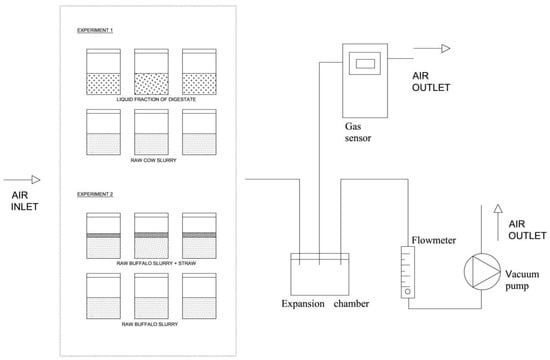
Figure 1.
Experimental setup used to measure gaseous emissions.
After being closed, each vessel was ventilated for 20 min in order to achieve steady conditions inside the chamber; then, the air was sampled for 16 min and analysed using a gas-sensitive semiconductor and electrochemical sensor (Aeroqual, series 500) to detect the real-time NH3 concentration.
The gaseous emission fluxes were evaluated as follows:
where Cin is the gas concentration of air inlet into the chamber in mg m−3; Cout is the gas concentration of air outlet from the chamber in mg m−3; Q is the airflow rate through the chamber in m3 h−1; and A is the circular area of the emitting surface in m2.
Cumulative emissions from each manure type over the storage period were evaluated by averaging net flux rates between two sampling points and by multiplying by the time interval between sampling points [23].
2.5. Statistical Analysis
Mean cumulative NH3 emissions within 24 h and over the whole measurement period were compared using a t-test at a significance value α = 0.05.
3. Results
3.1. Experiment 1
Some differences in terms of DM and OM contents for both types of manure at the beginning of storage are due to the treatments received. In particular, the DM content of CS differs about −35% from LFD, whereas the OM content in LFD (37.53 g kg−1) is lower than 45% of CS. As regards LFD, TKN (4.15 g kg−1) and TAN (2.46 g kg−1) contents are 8% and 25% higher compared to CS.
The higher DM content of CS, caused by the presence of the straw used for the litter, facilitates the formation of an air-dried crust. Visual observation indicated that the crust started to develop during the first week for the CS.
As reported in a recent paper [22], it is possible to observe both CS and LFD composition changed during the storage period. Specifically, the increase in DM content (216.9 and 181.9 g kg−1 for CS and LFD, respectively) can result from the water evaporation, whereas OM, TAN, and TKN content reductions were 1.6% and 5.2%, 46.4% and 88.9%, 39% and 74% for CS and LFD, respectively.
Figure 2 shows the cumulative ammonia emissions measured for the two types of manure investigated.
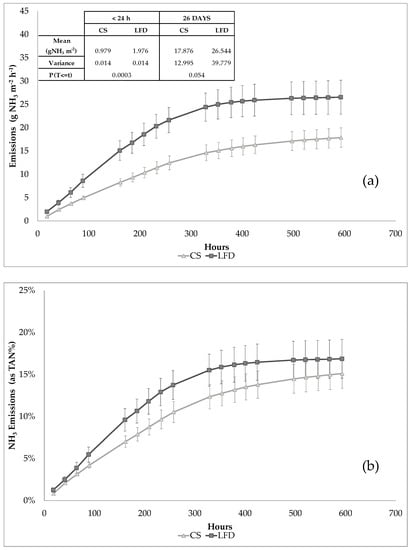
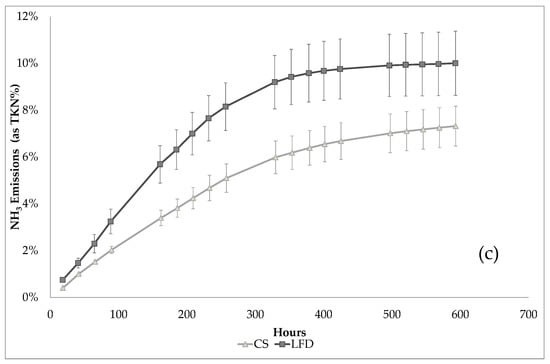
Figure 2.
Cumulative ammonia emissions measured during storage (a), as TAN% (b), and as TKN% (c). Error bars indicate SEM (n = 3). CS = Cow slurry; LFD = Liquid fraction of manure digestate.
Most of the NH3 emissions occurred during the first days, specifically LFD emitted more than CS till the 15th day. Mean cumulative NH3 emissions within 24 h was significantly higher from LFD than CS (p < 0.05), but it was not significantly different over the 26th day of the measurement period (Figure 2a).
Nevertheless, for both materials, it was observed a decreasing trend of NH3 emissions. Mainly, this phenomenon was recorded during the last week of the storage. Concerning the cumulative NH3 emission, CS demonstrates to emit 33% less than LFD. In particular, the cumulative emissions accounted for 17.9 g NH3 m−2 (15% as TAN and 7% as TKN) and 26.5 g NH3 m−2 (17% as TAN and 10% as TKN) for CS and LFD, respectively.
3.2. Experiment 2
The composition of the buffalo raw slurry was evaluated before and after the storage period. The measured pH resulted to be 7.13. The other characteristics are summarized in Table 3.

Table 3.
Buffalo raw slurry composition before and after the storage period: Dry Matter (DM), organic matter (OM), Total Ammoniacal Nitrogen (TAN), and Total Kjeldahl Nitrogen (TKN) content expressed on kg of fresh matter.
As expected, the period of storage affected buffalo raw slurry characteristics. As it is possible to observe, DM content increased mostly for BS; specifically, it accounts for 3 times the value recorded at the beginning of the storage. A similar trend was found also for the OM content. After the storage period, TKN and TAN content of BS and BSWS decreased. Specifically, TAN contents were 46% and 68% less than the values at the beginning of the storage for BS and BSWS, respectively. The TKN content of BS increased by 56% in comparison with the initial value. On the other hand, the TKN content of BSWS decreased by 14% during the storage period. To clarify the decreasing rate of TAN and TKN content, the values were referred to the DM content. TKN values referred to DM content proved to be 29.5 and 39.3 g × kg−1 DM for BS and BSWS, respectively, decreasing by 47.3% and 29.8%. Additionally, TAN referred to DM content as well and is 5.4 and 7.5 g × kg−1 DM for BS and BSWS, respectively. Thus, TAN values referred to DM content and showed a reduction of 74% and 81.4% for BSWS and BS, respectively.
From Figure 3, differences in ammonia emission fluxes can be observed. Specifically, on the first day after the straw application, an emission of 8 mg NH3 m−2 h−1 was recorded for BSWS, whereas the emission related to BS was 17.3 mg NH3 m−2 h−1. Mean cumulative NH3 emissions within 24 h was significantly higher from BS than BSWS (p < 0.05) (Figure 3a). The following days, an increasing trend occurred; for this reason, a new application of straw was planned at the beginning of the second week of monitoring. In this context, the reduction in ammonia emissions for the BSWS accounted for 77%. After 400 h, both emission curves followed a decreasing trend, with values of emissions next to zero.
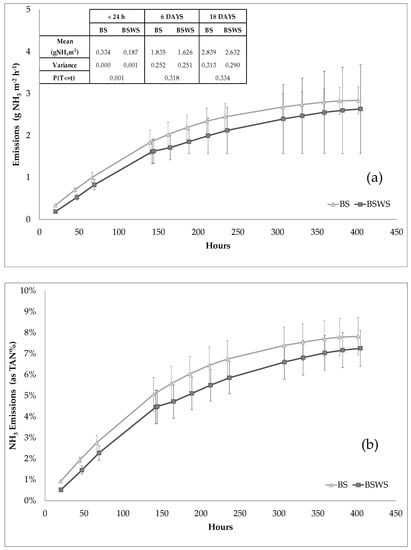
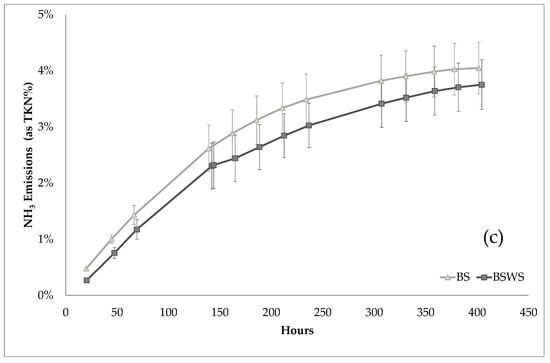
Figure 3.
Cumulative NH3 emissions from buffalo raw slurry with straw (BSWS) in comparison with buffalo raw slurry (BS) emissions without any cover expressed as g NH3 m−2 h−1(a), as TAN% (b), and as TKN% (c). Error bars indicate SEM (n = 3).
The overall reduction in terms of NH3 emissions associated with the straw application was 7.3%; specifically, the cumulative emissions accounted for 2.632 g NH3 m−2 (8% as TAN and 4% as TKN) and 2.839 g NH3 m−2 (7% as TAN and 3.7% as TKN) for BSWS and BS, respectively.
Mean cumulative NH3 emissions were not significantly different after 6 days with the second application of straw and over the 18th day of the measurement period (Figure 3a).
4. Discussion
The reported emissions could be used to assess the differences in terms of emissions between different manure treatments or covers application during the storage period. This aspect is fundamental for planning future researches and field studies.
4.1. Experiment 1
During the first experiment, the cover effects of the crust formation were observed. As found by previous studies [24], results suggested that the formation of a natural air-dried crust, which occurred mainly for the presence of straw bedding in the raw slurry not treated with solid–liquid separation, reduced the NH3 emissions. Particularly, Smith et al. [25] reported a reduction up to 60% on NH3 emission for crusted dairy slurry during the storage.
As found also by Misselbrook et al. [18], the slurry DM content affects the surface crust formation; in particular, there is no crust formation under 1% of DM. This is the explanation for crust formation: firstly occurring for the CS and afterwards for the LFD. To this purpose, another aspect should be considered, according to Smith et al. [25], slurry surface crust formation is promoted by the gaseous losses (CO2 and CH4) with the anaerobic process that occurred during storage. Indeed, in this case, the particles are raised up to the surface by the bubbles.
Also, the variation of chemical properties of the manures occurring during the storage was in good agreement with other studies [26], which have shown that these reductions are due to biological and chemical processes, responsible for gaseous emissions.
The higher NH3 emission fluxes observed for the LFD, as suggested by References [6,27], could be explained with the higher ammoniacal nitrogen in LFD at the beginning of the experiment (2.46 against 1.85 g kg−1 of CS) and the higher pH (7.9 instead of 7 of RS). On the other hand, it was observed a decreasing trend of ammonia emission fluxes for both materials. This could be explained with the occurrence at the same time as the natural crust development and the reduction of TAN content, considering that no other manure adding was provided during the study.
These findings suggest that naturally air-dried crust could be used as NH3 emission-reducing cover during the storage.
Nevertheless, initial manure characteristics could affect crust formation; specifically, dry matter (DM) content and livestock diet (grass silage) could facilitate the crusting [25]. For this reason, crust formation does not occur with the same timing and compactness for all the manure types.
4.2. Experiment 2
Straw promoted the differences in DM content at the end of the storage (Table 3), probably due to the different water evaporation of the samples. NH3 volatilization was confirmed by the reduction in terms of TKN and TAN found in both BSWS and BS, referring to the values in terms of DM content. An important implication of these findings is that the observed ammonia emission reductions are likely due to the absorption by straw covers floating on buffalo raw slurry. In this work [20] and in related references [28], it was observed that straw could reduce the NH3 volatilization since nitrogen can be immobilized by microorganisms.
Unfortunately, straw mitigation performances could be also affected by the DM content of the slurry; specifically, it was found by Finzi et al. [6] that straw has a lower mitigation effect on the emissions for pig slurry characterized by a low DM content. Indeed, in this context, the straw precipitation would be facilitated, as it happened during the trial after the first week of monitoring. Smith et al. [25] suggested using several straw applications to maintain the durability of the cover. Because of this, another layer of 1 cm of straw was applied after 142 h.
Furthermore, another possible explanation is provided by Dougherty et al. [3], which indicated that, generally, straw covers have short time-duration effectiveness due to their decomposition. Guarino et al. [29] showed in a study on pig and cattle slurry various levels of ammonia emission reduction. In the first case, the reduction was significant only when a thicker layer was applied to the slurry. In the second case, the reduction effectiveness ranged between 58.6% to 100% for two different thicknesses of wheat straw applied. Not only does wheat straw prove to be an efficient natural cover but maize stalks do as well. Moreover, in the case of pig slurry, the authors assumed that a thinner cover did not contribute to a reduction in emission because of the characteristics of the materials that get easily soaked.
Another study [30] showed the effect of straw and zeolite on the reduction of gas emissions from stored duck manure, applying a single layer of each material or a combination of them. Specifically, it was observed a reduction of 12% and 36% in terms of cumulative NH3 losses with straw covering and straw and zeolite combination, respectively.
These findings suggest the possibility to increase the straw reducing emissions effect by combining it with other materials.
5. Conclusions
From the two experiments carried out, it is possible to confirm that manure treatments such as SLS and AD modify the original manure characteristics and consequently affect the gaseous emissions during the manure storage. AD seems to enhance the NH3 emissions during storage (48.5% more than RS), in reason of the higher TAN content of LFD at the beginning of the storage. Additionally, the higher OM content in RS, mainly associated with the straw bedding in the manure, facilitated the surface crust formation starting from the first days of storage.
Regarding the straw application, it is evident that these experimental trials have shown an interesting implication not only for the reduction of the emissions during storage phase but also for the possibility of absorbing nitrogen fraction from the slurry. Certainly, this aspect could affect also the slurry application to the field. Because of this, the next stage of this research could be the validation of these results in full scale. Further study on other cover materials singularly or in combination with straw could improve the performances and the practical utilization of the bio-covers as well as the economic aspect.
In conclusion, different natural covers could be used during manure storage but the emissions mitigation effect is affected by the characteristics of the manure, including the same type of slurries.
Author Contributions
Conceptualization, E.S.d.P. and S.P.; data curation, E.S.d.P., A.M., and M.O.; funding acquisition, E.C. and S.P.; investigation, E.S.d.P., A.M., and M.O.; methodology, S.P. and E.S.d.P.; writing—original draft, E.S.d.P.; writing—review and editing, E.S.d.P., S.P., and A.M. All authors have read and agreed to the published version of the manuscript.
Funding
This research was realized under the Project RiAGRI-Sele funded by anaerobic digester plant and Rural Development Program for 2014–2020 of Campania Region (assigned to S.P) and with the facilities help of FFABR—Funding for Basic Activities Related to Research 2017 (MIUR) assigned to S.P.
Acknowledgments
The authors would like to thank prof. Salvatore Faugno, Nunzio Fiorentino, Roberto Maiello, and Sabrina Nocerino for their technical support in laboratory analyses. Authors would like to thank the Cirio Agricola Srl for financially supporting the research activities on the farm. Moreover, the authors want to thank Dianna Pickens for English revision of the manuscript.
Conflicts of Interest
Declare conflicts of interest or state “The authors declare no conflict of interest.” Authors must identify and declare any personal circumstances or interest that may be perceived as inappropriately influencing the representation or interpretation of reported research results. Any role of the funders in the design of the study; in the collection, analyses, or interpretation of data; in the writing of the manuscript; or in the decision to publish the results must be declared in this section. If there is no role, please state “The funders had no role in the design of the study; in the collection, analyses, or interpretation of data; in the writing of the manuscript; or in the decision to publish the results”.
References
- Dinuccio, E.; Biagini, D.; Rosato, R.; Balsari, P.; Lazzaroni, C. Organic matter and nitrogen balance in rabbit fattening and gaseous emissions during manure storage and simulated land application. Agric. Ecosyst. Environ. 2019, 269, 30–38. [Google Scholar] [CrossRef]
- Sommer, S.G.; Christensen, M.L.; Schmidt, T.; Jensen, L.S. Animal Manure Recycling: Treatment and Management; Jhon Eiley & Sons Ltd.: Chichester, UK, 2013; pp. 105–129. [Google Scholar]
- Dougherty, B.; Gray, M.; Johnson, M.G.; Kleber, M. Can biochar covers reduce emissions from manure lagoons while capturing nutrients? J. Environ. Qual. 2017, 46, 659–666. [Google Scholar] [CrossRef] [PubMed]
- Hartung, J.; Phillips, V.R. Control of gaseous emissions from livestock buildings and manure stores. J. Agric. Eng. Res. 1994, 57, 173–189. [Google Scholar] [CrossRef]
- Kirchmann, H. Losses, plant uptake and utilisation of manure nitrogen during a production cycle. Acta Agric. Scand. Suppl. 1985, 24, 1–77. [Google Scholar]
- Finzi, A.; Riva, E.; Bicoku, A.; Guido, V.; Shallari, S.; Provolo, G. Comparison of techniques for ammonia emission mitigation during storage of livestock manure and assessment of their effect in the management chain. J. Agric. Eng. 2019, 50, 12–19. [Google Scholar] [CrossRef]
- Scotto di Perta, E.; Fiorentino, N.; Gioia, L.; Cervelli, E.; Faugno, S.; Pindozzi, S. Prolonged sampling time increases correlation between wind tunnel and integrated horizontal flux method. Agric. For. Meteorol. 2019, 265, 48–55. [Google Scholar] [CrossRef]
- Pedersen, S.V.; Scotto di Perta, E.; Hafner, S.D.; Pacholski, A.S.; Sommer, S.G. Evaluation of a simple, small-plot meteorological technique for measurement of ammonia emission: Feasibility, costs, and recommendations. Trans. ASABE 2018, 61, 103–115. [Google Scholar] [CrossRef]
- Errico, A.; Lama, G.F.C.; Francalanci, S.; Chirico, G.B.; Solari, L.; Preti, F. Flow dynamics and turbulence patterns in a drainage channel colonized by common reed (Phragmites australis) under different scenarios of vegetation management. Ecol. Eng. 2019, 133, 39–52. [Google Scholar] [CrossRef]
- Flotats, X.; Bonmatí, A.; Palatsi, J.; Foged, H.L. Trends on manure processing in Europe. In Proceedings of the 2nd International Conference of WASTES: Solutions, Treatments and Opportunities, Braga, Portugal, 11–13 September 2013; pp. 11–13. [Google Scholar]
- Piccinini, S.; Bonazzi, G. Nuove strade per smaltire gli effluenti zootecnici. L’Informatore Agrar. 2005, 61, 55–60. [Google Scholar]
- Scotto di Perta, E.; Cervelli, E.; di Campagna, M.P.; Pindozzi, S. From biogas to biomethane: Techno-economic analysis of an anaerobic digestion power plant in a cattle/buffalo farm in central Italy. J. Agric. Eng. 2019, 50, 127–133. [Google Scholar] [CrossRef]
- Ariunbaatar, J.; Di Perta, E.S.; Panico, A.; Frunzo, L.; Esposito, G.; Lens, P.N.; Pirozzi, F. Effect of ammoniacal nitrogen on one-stage and two-stage anaerobic digestion of food waste. Waste Manag. 2015, 38, 388–398. [Google Scholar] [CrossRef] [PubMed]
- Scotto di Perta, E.; Collas, Y.; Fiorentino, N.; Cervelli, E.; Faugno, S.; Pindozzi, S. Ammonia emission assessment after buffalo manure and digestate application. In Proceedings of the EurAgEng 2018 Conference, Wageningen, The Netherlands, 8–12 July 2018. [Google Scholar] [CrossRef]
- Amon, B.; Kryvoruchko, V.; Amon, T.; Zechmeister-Boltenstern, S. Methane, nitrous oxide and ammonia emissions during storage and after application of dairy cattle slurry and influence of slurry treatment. Agric. Ecosyst. Environ. 2006, 112, 153–162. [Google Scholar] [CrossRef]
- Clanton, C.J.; Schmidt, D.R.; Nicolai, R.E.; Jacobson, L.D.; Goodrich, P.R.; Janni, K.A.; Bicudo, J.R. Geotextile fabric–straw manure storage covers for odor, hydrogen sulfide, and ammonia control. Appl. Eng. Agric. 2001, 17, 849. [Google Scholar] [CrossRef]
- VanderZaag, A.C.; Gordon, R.J.; Glass, V.M.; Jamieson, R.C. Floating covers to reduce gas emissions from liquid manure storages: A review. Appl. Eng. Agric. 2008, 24, 657–671. [Google Scholar] [CrossRef]
- Misselbrook, T.H.; Brookman, S.K.; Smith, K.A.; Cumby, T.; Williams, A.G.; McCrory, D.F. Crusting of stored dairy slurry to abate ammonia emissions. J. Environ. Qual. 2005, 34, 411–419. [Google Scholar] [CrossRef] [PubMed]
- Rotz, C.A. Management to reduce nitrogen losses in animal production. J. Anim. Sci. 2004, 82, E119–E137. [Google Scholar]
- Kirchmann, H.; Witter, E. Ammonia volatilization during aerobic and anaerobic manure decomposition. Plant Soil 1989, 115, 35–41. [Google Scholar] [CrossRef]
- APHA. Standard Methods for the Examination of Water and Wastewater, 21st ed.; American Public Health Association: Washington, DC, USA, 2005; ISBN 0875530478. [Google Scholar]
- Scotto di Perta, E.; Cervelli, E.; Faugno, S.; Pindozzi, S. Monitoring of NH3 and CH4 emissions from dairy cows under storage conditions. In Proceedings of the 2019 IEEE International Workshop on Metrology for Agriculture and Forestry (MetroAgriFor), Portici, Italy, 24–26 October 2019; pp. 35–39. [Google Scholar]
- Pampuro, N.; Dinuccio, E.; Balsari, P.; Cavallo, E. Evaluation of two composting strategies for making pig slurry solid fraction suitable for pelletizing. Atmos. Pollut. Res. 2016, 7, 288–293. [Google Scholar] [CrossRef]
- Aguerre, M.J.; Wattiaux, M.A.; Powell, J.M. Emissions of ammonia, nitrous oxide, methane, and carbon dioxide during storage of dairy cow manure as affected by dietary forage-to-concentrate ratio and crust formation. J. Dairy Sci. 2012, 95, 7409–7416. [Google Scholar] [CrossRef]
- Smith, K.; Cumby, T.; Lapworth, J.; Misselbrook, T.; Williams, A. Natural crusting of slurry storage as an abatement measure for ammonia emissions on dairy farms. Biosyst. Eng. 2007, 97, 464–471. [Google Scholar] [CrossRef]
- Evans, L.; VanderZaag, A.C.; Sokolov, V.; Baldé, H.; MacDonald, D.; Wagner-Riddle, C.; Gordon, R. Ammonia emissions from the field application of liquid dairy manure after anaerobic digestion or mechanical separation in Ontario, Canada. Agric. For. Meteorol. 2018, 258, 89–95. [Google Scholar] [CrossRef]
- Baldé, H.; VanderZaag, A.C.; Burtt, S.D.; Wagner-Riddle, C.; Evans, L.; Gordon, R.; MacDonald, J.D. Ammonia emissions from liquid manure storages are affected by anaerobic digestion and solid-liquid separation. Agric. For. Meteorol. 2018, 258, 80–88. [Google Scholar] [CrossRef]
- Sommer, S.G.; Møller, H.B. Emission of greenhouse gases during composting of deep litter from pig production–effect of straw content. J. Agric. Sci. 2000, 134, 327–335. [Google Scholar] [CrossRef]
- Guarino, M.; Fabbri, C.; Brambilla, M.; Valli, L.; Navarotto, P. Evaluation of simplified covering systems to reduce gaseous emissions from livestock manure storage. Trans. ASABE 2006, 49, 737–747. [Google Scholar] [CrossRef]
- Wang, J.Z.; Hu, Z.Y.; Zhou, X.Q.; An, Z.Z.; Gao, J.F.; Liu, X.N.; Hao, Y.B. Effects of reed straw, zeolite, and superphosphate amendments on ammonia and greenhouse gas emissions from stored duck manure. J. Environ. Qual. 2012, 41, 1221–1227. [Google Scholar] [CrossRef] [PubMed]
© 2020 by the authors. Licensee MDPI, Basel, Switzerland. This article is an open access article distributed under the terms and conditions of the Creative Commons Attribution (CC BY) license (http://creativecommons.org/licenses/by/4.0/).